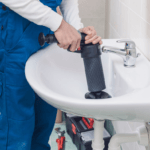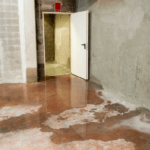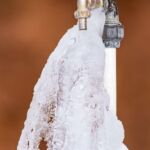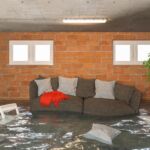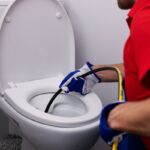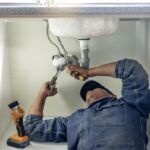A sump pump is a critical device installed in basements prone to water intrusion. It sits in a pit at the lowest point of the basement floor and activates when water reaches a certain level, using a pump to force water out through pipes to a safe drainage area. By removing groundwater and leakage from broken pipes or appliances before it floods the basement, a properly functioning sump pump provides invaluable protection.
However, sump pumps can and do fail from time to time. Their electrical and mechanical parts can become blocked, disconnected or simply wear out. In some severe weather situations, the pump may be overwhelmed by the sheer amount of water flowing into the basement and be unable to keep up. Understanding why basement flooding happens even with a sump pump and how to prevent pump failure is crucial to protect your home.
Causes of Basement Flooding Despite a Sump Pump
There are several common reasons a basement can flood even with a sump pump installed:
Clogged Gutters – When gutters fill up with leaves and debris over time, they can overflow during heavy rain or snowmelt. The water runs off the roof and pools around the home’s foundation, seeping into the basement. Keeping gutters clean and free of clogs ensures proper drainage and diversion of water away from your home.
Broken Downspouts – Downspouts are supposed to direct water from gutters away from the house. But if they become damaged or disconnected, that water instead flows down the outer walls and towards the basement. Periodically inspect downspouts for any needed repairs or realignment.
Inadequate Waterproofing – If the basement was not properly waterproofed and sealed during construction, water can gradually seep in through cracks and holes in the concrete, especially in wet climates or flood zones. Proper waterproofing techniques must be used.
Undersized Sump Pump – Sump pumps are rated to handle average weather conditions and typical regional rainfall. But an unusually high volume of water from heavy storms or rapid snowmelt can overtax an undersized pump. Consider upsizing for a generous safety margin.
Power Outage – Standard sump pumps run on household electricity. When power goes out during storms, the pump stops working unless it has a backup power source. A battery backup system or generator ensures the pump keeps running during an outage.
Overworked Pump – Running too often without breaks causes a pump to wear out faster. Ensuring downspouts, gutters and surface grading direct water away from the home can reduce pump cycles and strain.
Nearby Plumbing Leaks – Leaky pipes in the basement ceiling or a hot water tank can drip considerable amounts of water over time. Regular inspections and maintenance help detect plumbing issues early.
Preventing Sump Pump Problems
Routine maintenance and proper installation reduces the risk of sump pump failure leading to flooded basements:
- Test the pump regularly by pouring water into the pit to trigger the pump and ensure it runs when required.
- Install a battery backup system or generator to power the pump during outages.
- Use two pumps for redundancy in case one fails or gets overwhelmed.
- Keep the sump pit clear of dirt, debris and mold buildup which can clog the pump.
- Hire experienced professionals for installation per manufacturer specifications. DIY mistakes often lead to early failure.
- Size the pump adequately for the home’s expected weather conditions and water volumes. Overpower for heavy duty performance.
- Replace the pump every 5-7 years or according to recommendations to prevent age-related breakdowns.
Addressing a Flooded Basement
Even well-maintained sump pumps sometimes fail, resulting in a flooded basement. Act quickly to minimize damage:
- Call a plumber to determine why the basement is flooding and fix the root cause. Speed is critical to prevent permanent moisture issues.
- Shut off electricity at the breaker if there is significant standing water, to prevent electrocution and appliance damage.
- Move valuables like boxes and furniture to upper levels so they stay dry. Assume items left on the floor will get wet.
- Use water pumps and wet/dry vacuums to extract as much standing water as possible. The less time water sits, the better.
- Inspect the sump pump and pit for any blockages, and clear them so the system works again.
- Have the failed sump pump replaced with a new unit as soon as possible by a professional.
- Take photos of all flooding and damage for insurance claims that may help cover pump repairs or replacement.
While flooded basements cause headaches, taking quick action to address the root issue, limit water damage, and get drainage restored can help mitigate the impacts. Calling a plumber right away is advised whenever flooding occurs. Investing in robust sump pump solutions will also help avoid problems down the road.
In Summary
A properly working sump pump is essential to keep basements dry and prevent costly water damage. However, pump failures can and do occur due to a variety of reasons. Staying on top of maintenance, inspection and testing is key to reducing failure risk. If flooding does happen, taking rapid action to address the source, extract water, and restore drainage can help minimize impacts. Investing in robust backup pump systems and waterproofing also provides an added layer of protection from wet basements. With proper precautions and response plans in place, sump pump failure does not have to spell disaster.
If you are experiencing any basement flooding issues or sump pump failures, don’t wait – take action now. Contact the experts at Tap Tech for fast, reliable plumbing services.
With over 25 years of experience in residential and commercial plumbing, we are committed to helping homeowners like you restore order when basement flooding or sump pump failure strikes. Our team of fully licensed, experienced plumbers are available 24/7 to rapidly respond, diagnose the root cause, and implement solutions to get your drainage working properly again. We utilize the latest techniques and equipment, yet provide transparent, upfront pricing so you aren’t surprised by hidden fees.
Call us anytime at 343-305-1172 for emergency plumbing assistance. Customer satisfaction is our top priority.


